Amazing Animals #4 The Blue Whale
As a child growing up surrounded by movies like Jurassic Park, Free Willy and TV shows documented by the incredible Sir David Attenborough showcasing the natural world and the most incredible animals we share it with I was inspired to work with animals. I have always had a fascination with cetaceans such as Orca whale and Dolphins and at the age of 6 I stated to my Mum that I wanted to be a Marine Biologist, by 13 I found SeaWorlds Live Webcams on their website for their Orca whales and would wait at 6:30pm every night to see them swim around.
I was awestruck when I contacted them for advice to chase my dreams and they replied with a wonderful email from one of their head trainers. At 14, the most incredible documentary hit our screens - The Blue Planet, with some of the worlds first footage of some elusive species. Although I did not pursue my dream of working as a Marine Biologist (I do not have sea-legs) I still find it incredible that there are animals out there we still do not know a lot about and one of those is the Blue Whale (Balaenoptera musculus)
The Largest Animal on Earth
As mentioned they are the largest animals to have ever existed, Blue Whales belong to the Baleen Whale family and an average individual measures roughly 82 feet in length with some larger than average Blue Whales measuring over 100 foot, for perspective you’d have to line up three School Buses in a row in order to achieve the same length as the largest Blue Whale ever recorded.
Comparatively there were Herbivorous Dinosaurs that were the same length as the Blue Whale, none however were even on the same spectrum as the Blue Whale when considering body mass. Blue Whales are easily the heaviest animals that have ever existed, that we know of, as the oceans are deep and we haven’t uncovered fossils in the same way that we have with land dwelling Dinosaurs. The average Blue Whale weighs an incredible 140,000Kg’s and a larger than average Blue Whale can weigh up to 200,000Kg’s, for a size comparison that is over 2660 average humans, or two Boeing 737 Jumbo Jets!
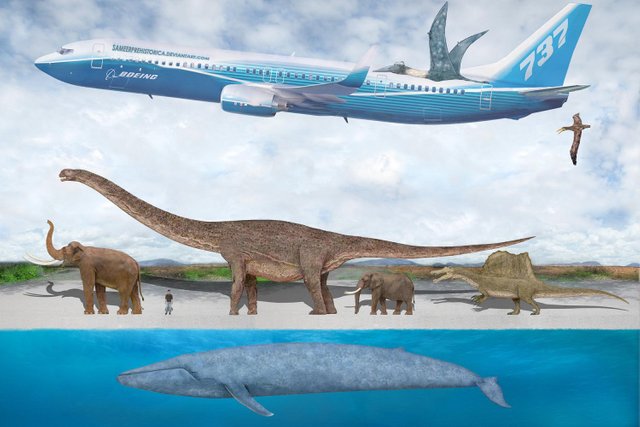
Source: Size comparison of a Blue Whale compared to Prehistoric animals and a Boeing 737 Jetliner
Diet of a Giant
As members of the Baleen family, Blue Whales do not have teeth and instead have a series of coarse bristled plates known as Baleen plates, Blue Whales have 320 pairs of Baleen plates measuring 1 meter each which they use to capture and filter their prey, random fact, the largest Baleen plates belong to the Bowhead Whale and are 4m long, roughly one third of its body length.
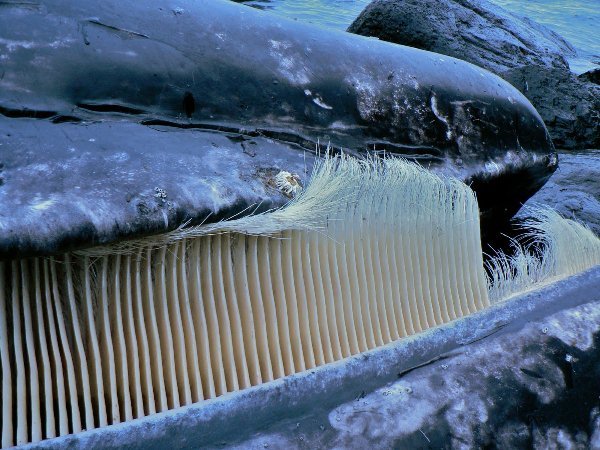
Source: Baleen plates of a Blue Whale
Obviously, a Blue Whale will not have the luxury of rich feeding situations all year round, luckily it doesn’t need them at all as it has one of the most efficient feeding processes in the animal Kingdom. Blue Whales predate on Krill by diving down to depths of around 500 feet, they then perform what’s referred to as a ‘lunge’ by approaching the Krill from below the Blue Whale opens its mouth drawing in several tonnes of water along with huge densities of Krill at a time, the Whale then pushes the water through its large Baleen plates where the Krill are captured.
This entire process is hugely energy consuming with Scientists calculating the average Lunge expends 3200 Kilojoules of Energy or roughly the same as an 8 Mile run for a Human. The Blue Whale does however compensate this expenditure with the huge volume of food consumed per lunge which can equate to over 1,900,000 Kilojoules, even when including the energy costs of dives the Blue Whale is still gaining more than 90 times its energy expenditure per lunge, this feeding method and energy return allows the Blue Whale to go up to 8 months with little to no food relying solely on its stockpiled fat reserves, no other Animal on Earth can compete with its hunting efficiency.
Migration and Breeding
Blue Whales are present in every Ocean on Earth apart from the Arctic, and all of them migrate annually to and from Breeding grounds around the Equator and Tropics to the Feeding grounds in the Southern or Northern Hemisphere during the Summer months between November/February and June/August respectively.
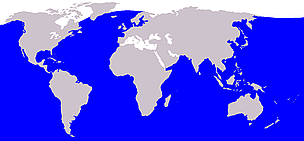
Source: Blue Whales range is truly Global
What we do know is that Blue whales have a gestation period of 11 months and their calves are always born after the feeding season has ended. Testament to the previously mentioned reserves of Energy a mother Blue Whale gathers during the feeding season, she can feed her Calf over 250 litres of Fat-laden milk per day for 8 months whilst barely feeding herself, when the Calf is born it weighs up to 7000Kgs and measures 7.5 meters in length, by the time it is weaned from its mother it will be over 15 meters long and weigh over 22500Kgs, this is a growth rate of roughly 3.5Kgs per hour. (It should be noted that recent research has shown that Blue Whales off the coast of Costa Rica have been observed continuing to feed throughout the Breeding season, more research is required to attain whether this behaviour is widespread.)
Threats
As the largest Animal on Earth the Blue Whale has no natural predator and is one of the true Apex predators of the animal kingdom, A newborn calf can however be killed by a group of Orca that can overcome its large size with intelligence, with no natural predators this is the main factor that has allowed them to grow to such gargantuan sizes.

Source: Example of a Blue Whale on board a Whaling Vessel
Shortly after, in 1967 a global ban on the hunting of Blue Whales was put in place, making them one of the first high profile animals to gain International protection. Sadly by this point Blue Whale populations were less than 1% of what they were before the advent of Whaling, and to this day their figures are still low enough to be considered Vulnerable to extinction though their numbers are increasing, the rebound of their populations has been slowed as they now face a new threat. With global cargo traffic at an all-time high, boat-strikes are becoming more and more common, combined with the added noise in our Seas the Blue Whale may also be struggling to locate potential mating Partners, furthermore we are polluting our Oceans at an increasingly fast rate with Plastics, Oil spills and liquid waste, our Marine wildlife is paying the price for our conveniences.
Amazing Facts
- The anatomy of their mouths is mind-boggling, their fleshy tongue can weigh up to 3000Kgs and is used to extract Krill from its Baleen plates. Their mouth is aligned with a series of vertical Pleats that stretch down to its throat, this allows the Blue Whales mouth to expand to a size that unbelievably allows it to consume a volume of water and Krill larger than itself, over 90000Kgs, imagine being able to hold your own body mass in your mouth. Despite these huge numbers their Throat passage is only 30Cm wide, so they are incapable of accidentally swallowing large items.
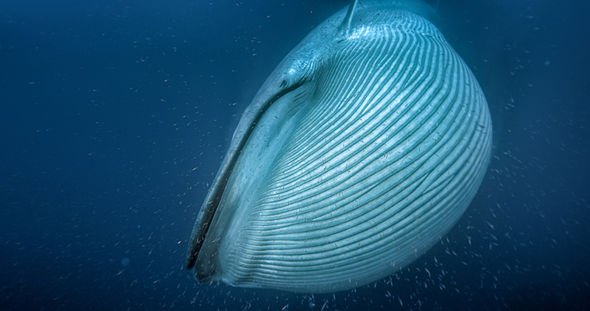
Source: A Blue Whale just after performing a lunge - Their Heart can weigh as much as 190Kgs and measures roughly 1.5 meters in all directions, it is capable of pumping 220 litres of Blood around the Blue Whales massive frame with every beat, its heartbeat can also be heard from up to 1.6 Miles away with the right equipment. Blue Whales on average have 10,000 litres of Blood, unsurprisingly the largest volume of Blood in any animal, their Aorta being their largest Artery is around 25Cm wide so sadly you cannot swim through a Blue Whales veins like you may have read or been told.
- Their Lungs are over 12 meters long and can hold up to 5000 litres of air on a single breath, this would be enough air to inflate 2000 party Balloons.
- Blue Whales are roughly 1300 times larger than the prey they feed on, if we were to eat in the same way we would never consume anything larger than a grain of sand.
- It is widely believed that Blue Whales can live for over 100 years, this is calculated by analysing layers of wax within their Ears.
- DNA evidence has shown that Blue Whales likely share a common ancestor with Hippopotamus’ and they are in fact their closest living relatives (excluding other Baleen and Toothed Whales).
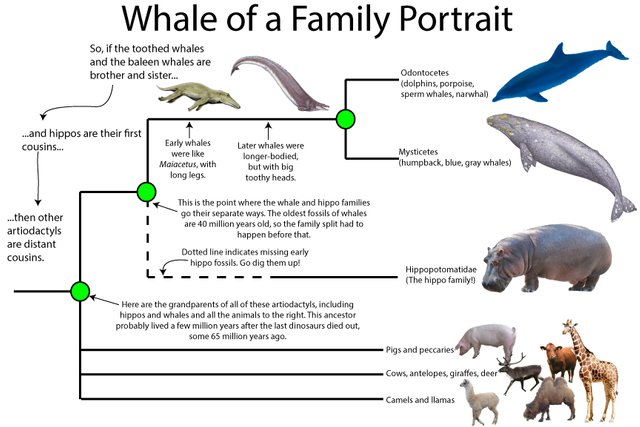
Source: Evolutionary family tree of the Blue Whale
- They are the loudest animal on Earth, their 190 Decibel song is louder than a Jet engine and prior to cargo traffic their sound likely carried for up to 1000Kms, in today’s Oceans it will be lucky to carry for 100Kms, with fewer Blue Whales this puts a real strain on finding a breeding partner.
- Blue Whales aren’t Blue, they are predominantly Grey in colour, their name derives from their Blueish colour when they are just under the water’s surface.
Amavis Amazing Animals Poo Fact
Unsurprisingly they have the world’s largest faeces, a plume of their faeces can stretch for up to 30 meters! It is also vibrant in colour, specifically Orange and Red, this is due to the Orange husks of the Krill it consumes as well as the high Iron content in the Whales diet. Blue Whale poop actually aids with the Nitrification process in coastal waters which contributes to blooms of Zooplankton, the building blocks of the Marine food-chain.
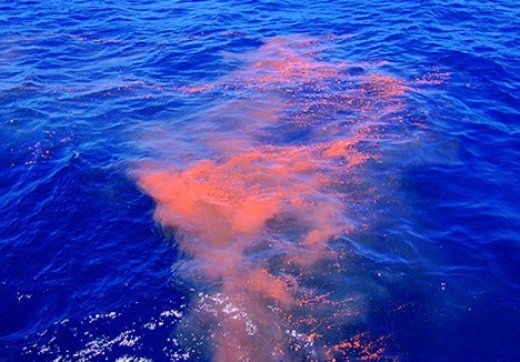
Source: The vibrant Poop of the Blue Whale
Seeing these magnificent animals in the wild is quite difficult and often expensive, but if you’re ever in London make sure to stop by at the Natural History Museum, a fully restored Blue Whale skeleton now takes pride of place in the main entrance gallery, the skeleton is from a female Blue Whale who has aptly been named ‘Hope’.
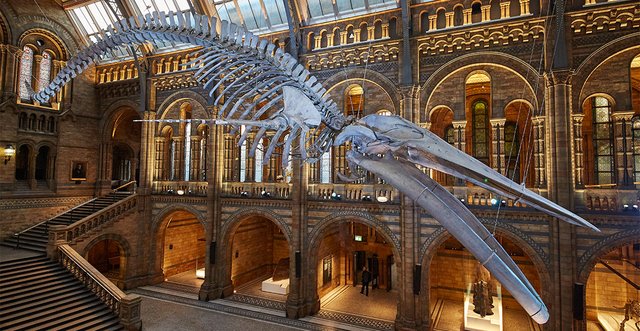
Source: The Skeleton of Hope in the Hintze Gallery at the London Natural History Museum
Content sources: 1, 2, 3, 4, 5, 6, 7, 8
If you enjoyed this edition of Amazing Animals you may be interested in some of my previous posts:
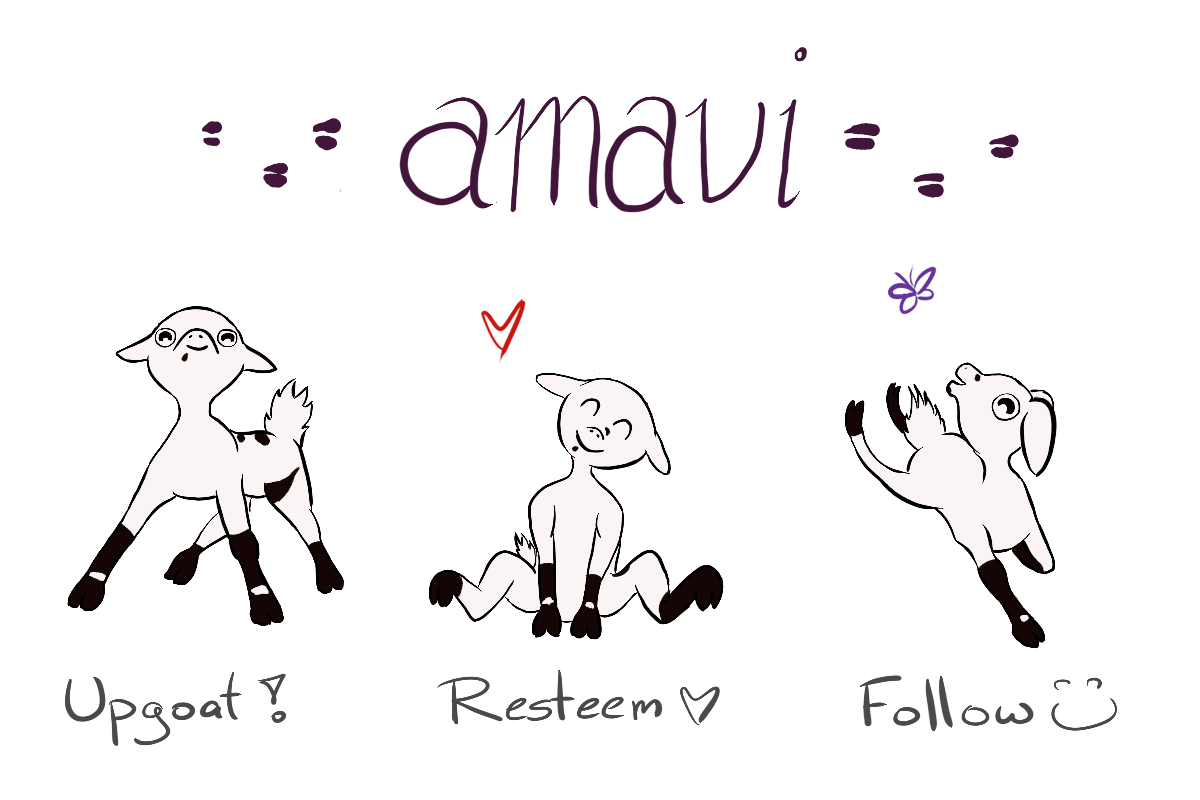
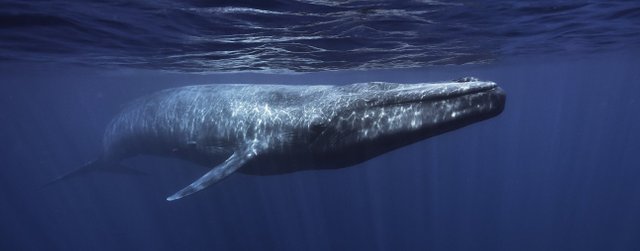
It is a pity that such whales remained on the planet very little
@originalworks
The @OriginalWorks bot has determined this post by @amavi to be original material and upvoted(1.5%) it!
To call @OriginalWorks, simply reply to any post with @originalworks or !originalworks in your message!
I find the thought of a 190 kg heart pumping 10000 litres of blood strangely calming. I will have to try and think about it when I get an anxiety attack next.
Their circulatory system is incredible, I might cover it in more detail in a future post.
A beautiful mammal and amazing creature. It would be a shame to see it disappear from the face of the earth. It will take many more years under protection for their number to increase to where they were before the hunting began.
It will take centuries, maybe even Millennia to get back to the figures that were present before Whaling, I should have noted they breed on average every 3 years and only have a single Calf at a time, we can at least be thankful that their numbers are increasing at a slow and steady rate. :)
This post has received a 3.16 % upvote from @buildawhale thanks to: @amavi. Send at least 1 SBD to @buildawhale with a post link in the memo field for a portion of the next vote.
To support our daily curation initiative, please vote on my owner, @themarkymark, as a Steem Witness
Such amazing creatures!! Very interesting and informative post! Thanks!
Thanks, they are amazing! I'd love to see one in the wild one day, one can dream. :)
I hope you do get the chance to do so. Oahu, this time of the year is supppsed to be the place to be for whale lovers!!
I will bare that in mind!!
Whales are awesome! The Humpback is my favourite but the blue whale is also an amazing creature. Thank you for this post, very educative :)
Thank you for your comment, I am glad you enjoyed this Amazing animal
With all the technology at our disposal it is quite interesting to realize that we still don't know where Blue Whales mate or give birth. What a great mystery!
Isn't it amazing there are still mystery's out there?
this is awesome ! I LOVE your posts as much as I love animals ! thank you so much for feasting me with your writings and documentary
Thank you so much for your lovely comment :)
This post was promoted with @monitorcap traffic bot & STEEM promotion service.
Send MIN. $1 SBD to @monitorcap bot with your link in MEMO field
and recieve upvotes & resteems for your posts. @monitorcap - where 'seen' matters !